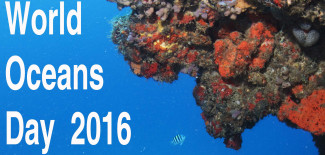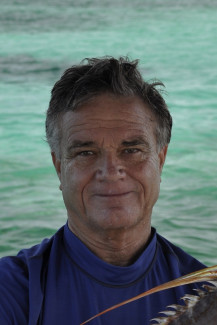
Johns Hopkins UniversityEst. 1876
America’s First Research University
World Oceans Day: A celebration of marine fishes

Today is World Oceans Day. Hundreds of organizations around the globe are gathering for beach cleanups and education events for a cleaner ocean and a healthier future. In honor of the occasion, we’ve invited Marine Fishes of Florida authors David B. Snyder and George H. Burgess to talk about the inspiration behind their project, and a look at conservation efforts in their area.

David B. Snyder

Over our combined 70+ years studying Florida fishes we were always questioned by anglers, divers, colleagues, and interested bystanders about fishes being caught or observed: “what is it?”; “ what does it eat?”; “how big does it get?”; “what’s it doing here?“ ; “ can it hurt you?”; and, a perennial favorite, “do the local restaurants serve it fresh”? Answering these and endless other questions requires a source that bridges the gap between regional field guides, extensive field experience, and the scientific literature. This was the concept behind our book-- Marine Fishes of Florida.
George and I discussed writing a book on Florida fishes back in the late 1970’s when we were both ambitious students. We felt that Florida’s diverse fish fauna deserved its own document—one that would not only illustrate various species with color photographs but also describe their habits and habitats from a Florida perspective. As with many good intentions the idea and motivation faded, but never totally vanished. We ventured into separate careers as professional biologists all the while adding to our photographic files, field notes, and data archives pertaining to Florida marine fishes.
Decades later when JHUP asked us if we would be interested in writing a book on Florida’s marine fishes we were elated. We assumed with all the information (hundreds of 35 mm slides, digital images, field notes, personal libraries, and the ichthyological collection of the Florida Museum of Natural History) at our fingertips producing such a book would be relatively easy. Reality set in as we began to outline the project and assemble images for members of our target 133 fish families. Despite the knowledge base we were sitting on, the need for more images and research surfaced. To obtain desired images we traveled to various places around the state including the Florida Keys, Merritt Island, Vero Beach, Crystal River, and the Florida Middle Grounds (70+ miles off the west coast) to name a few. Down the stretch we lobbied friends and colleagues for a few hard to find photographs. Combining images with descriptive text also took more energy than we originally expected. It turned out we are both master procrastinators who work best when the pressure is on; so much of the writing, editing, and fact-checking happened at the eleventh hour. Seeing the finished product was a just reward for working many nights and weekends to avoid conflicts with family obligations and our demanding day jobs.
Now when standing on the shore or boat deck and an angler, diver, or other interested party asks a question about some fish they caught or observed, we will answer and then point to our colorfully-illustrated printed volume.
George H. Burgess
Just this week a couple of anglers fishing for sea trout in the Big Bend area of Florida were pleasantly surprised when the “big sharks” that took their live baits turned out to be 20+ pound snooks. Younger fishers pronounce the species like “b-ook” but older Florida Conchs still refer to this highly-sought gamefish as “s-nuke,” a much more melodious sound to this ole fish guy’s ears.
Although I’ve been studying Florida fishes for more than 40 years, I’m still regularly excited by seeing alterations of natural distributional patterns or by observing new behaviors I haven’t experienced. Snook at one time were regularly caught north of Tampa Bay, but over the period of my tenure here in Florida they largely became a south Florida species. Interestingly they now are popping up more commonly in their old haunts in the northeastern Gulf of Mexico during warm water months, perhaps in part because of warming waters associated with global climate change. Other tropical summer residents in the region include large tarpon, the granddaddy of all Florida gamefishes, and a variety of reef-associated species such as groupers, snappers and damselfishes. Some arrive as larvae swept into these waters while others simply swim here to take advantage of a rich food supply.
The arrival of snooks indicates that it’s officially summer in the Big Bend-Panhandle region of Florida, a boon for fishers and fish guys alike.
David B. Snyder is a senior scientist with CSA Ocean Sciences Inc. His photographs of fishes have appeared in numerous field guides and technical and popular publications. George H. Burgess is 


